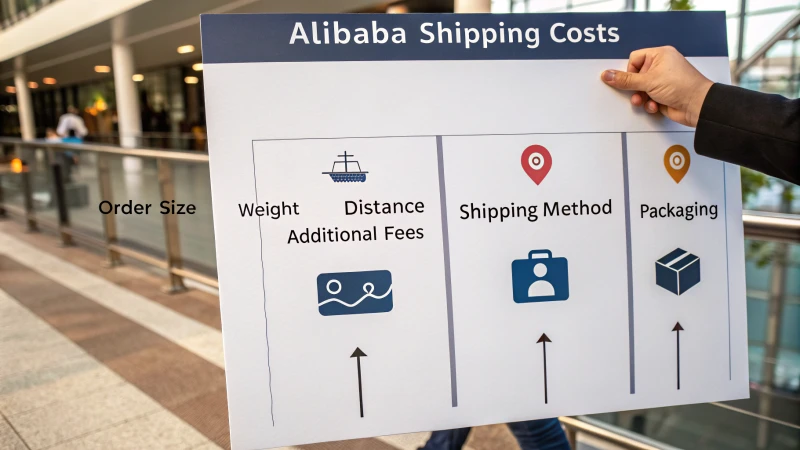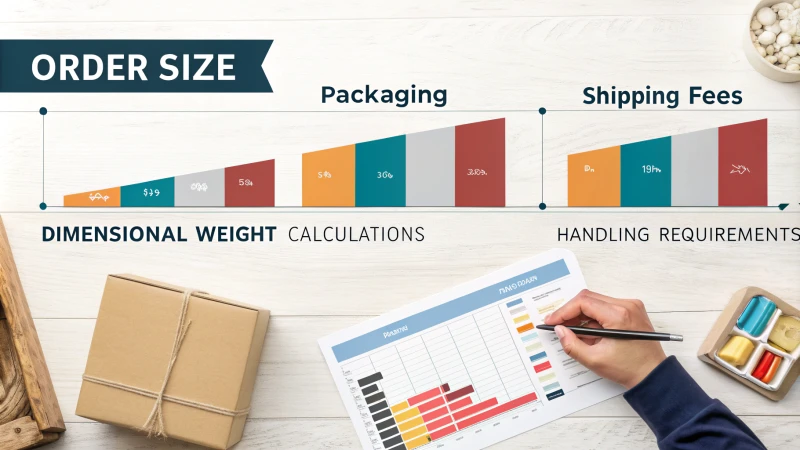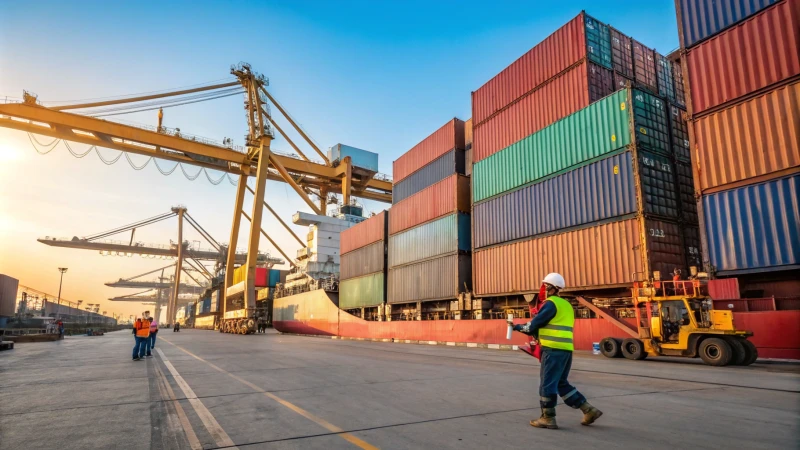Have you ever wondered why those Alibaba shipping costs seem sky-high?
Shipping from Alibaba can be pricey because of factors like order size, packaging, distance, weight, chosen shipping methods, additional fees, and market dynamics.
I remember my first big order from Alibaba. The excitement of scoring a great deal quickly turned to shock when I saw the shipping quote. It's not just about the distance or weight; it's the complex web of logistics that adds up. But don't worry! By understanding these cost drivers, you can make smarter choices and potentially save a bundle.
Order size affects Alibaba shipping costs significantly.True
Larger orders often lead to higher shipping costs due to increased weight and volume.
Alibaba offers free shipping for all orders.False
Shipping costs on Alibaba vary based on factors like distance, weight, and method.
What Are the Main Factors Affecting Alibaba Shipping Costs?
Picture this: you're eagerly waiting for your latest Alibaba order, but shipping costs are sky-high. Why? Let's break it down together.
Alibaba shipping costs depend on order size, distance, weight, shipping method, packaging, and extra fees. Each factor can change your final bill, so making smart decisions can really help keep costs in check.

Order Size and Packaging
The size of your order significantly influences shipping costs. A few years back, I placed a small order thinking it'd save me money. Surprise! The per-unit shipping cost was higher than expected. It turns out, larger orders often qualify for bulk discounts, saving you more in the long run.
Choosing appropriate packaging is essential to minimize volume1 and weight, thus reducing shipping expenses. I remember packing my products in unnecessarily large boxes once and got hit with extra fees for volume. Now, I always choose snug, custom packaging to cut down on wasted space and avoid hefty charges.
Distance and Weight Considerations
The distance between the supplier and the destination directly affects shipping costs. Shipping from China to the UK meant navigating zones and high costs. Nowadays, I try to pick suppliers closer to home to keep costs manageable.
Weight is another critical factor. One heavy shipment taught me to look for lightweight materials that don't compromise quality. Trust me, every pound counts when you're trying to keep shipping expenses down.
| Factor | Impact on Cost |
|---|---|
| Distance | Longer distances increase costs |
| Weight | Heavier items lead to higher fees |
Chosen Shipping Methods
Deciding on a shipping method can feel like a game of chess. Different shipping methods have varying costs and delivery times. For instance, sea freight might be slow but it’s budget-friendly, unlike air freight which is quick yet pricey. Evaluate your business needs to choose the most cost-effective method2.
Express services like DHL or FedEx are tempting for their speed but at a premium price. It’s all about finding that sweet spot between cost and delivery time.
Additional Fees and Market Dynamics
One surprise customs duty bill was enough to teach me the importance of understanding additional fees. Customs duties, taxes, and other additional fees can dramatically alter shipping costs. Now, I factor in duties and taxes early on to avoid nasty surprises.
Market dynamics such as fuel price fluctuations and political shifts also impact shipping rates. Staying informed helps me anticipate changes in shipping rates and plan accordingly.
| Fees | Description |
|---|---|
| Customs Duties | Taxes imposed by governments |
| Fuel Surcharges | Additional fees due to fuel price changes |
Navigating these factors has made me more strategic in managing my shipping costs. Whether it's through consulting with logistics experts or making smarter choices based on past experiences, I've learned that staying informed and adaptable is key to optimizing my shipping strategy.
Larger orders always cost more to ship than smaller ones.False
Larger orders may benefit from bulk shipping discounts, reducing costs.
Air freight is generally cheaper than sea freight.False
Sea freight is often cheaper but slower compared to air freight.
How Do Order Size and Packaging Affect Shipping Fees?
Ever wondered why some packages cost more to ship than others? Let me share my journey of learning how order size and packaging can dramatically change shipping fees.
Order size and packaging play a crucial role in determining shipping fees due to dimensional weight calculations and handling needs. Larger or heavier packages typically cost more, so by optimizing these aspects, businesses can achieve significant cost savings.

Dimensional Weight and Volume Pricing
When I first delved into the world of international shipping, the concept of dimensional weight caught me off guard. Imagine my surprise when I found out that a large but light package could end up costing more than a smaller, heavier one! It's all about how much space your parcel occupies versus its actual weight. Companies like FedEx and UPS use this dimensional weight model to make sure they utilize every inch of space in their trucks effectively. So, understanding how these fees are calculated really helped me make smarter packaging decisions.
| Factor | Impact on Fees |
|---|---|
| Order Size | Larger orders can lead to bulk discounts but may also increase dimensional fees. |
| Packaging Material | Heavier materials add weight, potentially raising shipping costs. |
| Shape and Density | Irregular shapes may incur additional handling fees. |
Packaging Strategies to Reduce Costs
Choosing the right packaging was a game-changer for me. I remember a time when I was frequently overpaying on shipping due to using boxes that were too big for my products. Switching to snug-fitting, lightweight boxes saved me a ton! It’s like finding the perfect puzzle piece—everything just clicks, and you’re not paying for empty space.
- Optimized Packaging: Tailor boxes to product size to avoid excessive empty space3.
- Material Selection: Choose materials that are sturdy yet lightweight to balance protection with cost-efficiency.
Bulk Shipping Considerations
Another lesson I learned was the delicate balance of ordering in bulk. Yes, bulk buying can offer amazing discounts, but it’s essential to consider potential increases in handling and storage costs. It's like buying a jumbo pack of toilet paper—great savings but tricky storage!
- Bulk Discounts: Many carriers offer reduced rates for large shipments, but these must be balanced with potential storage fees4.
- Handling Costs: Larger shipments may require special equipment, increasing handling expenses.
By navigating these insights, I've been able to streamline my logistics process, ensuring I choose the most cost-effective methods while keeping my products safe during transit. If you're as curious as I was about digging deeper into this topic, exploring industry best practices5 can offer even more detailed strategies on cutting down those pesky shipping fees.
In the next sections, I'll explore how different shipping methods6 influence cost structures and provide tips on navigating these complexities effectively.
Dimensional weight affects shipping costs more than actual weight.True
Dimensional weight considers volume, often leading to higher costs than actual weight.
Irregularly shaped packages always lower shipping fees.False
Irregular shapes can incur additional handling fees, increasing costs.
How Can Choosing the Right Shipper Save You Money?
Ever wondered how much you could save just by picking the right shipper? It’s more than you might think, and it could be a game-changer for your business.
Choosing the right shipper can significantly cut down your expenses by streamlining logistics, securing better rates, and opting for shipping methods that align perfectly with your business needs.
Factors Influencing Shipping Costs
Reflecting on my own experiences in the import/export trade, I remember grappling with unexpected shipping expenses. What a revelation it was to learn that elements like shipping method, distance, package weight, and additional fees were crucial. Imagine realizing that opting for less-than-container load (LCL) instead of full-container load (FCL) could actually save money if you don't have enough cargo to fill a container! Diving deep into these aspects taught me how vital it is to negotiate better rates7 and make savvy shipping choices.
Comparing Shippers: A Strategic Approach
When I first started comparing shippers, it felt like a massive task. But creating a simple comparison table was a game-changer:
| Shipper | Cost Per Shipment | Reliability Rating | Additional Services |
|---|---|---|---|
| Shipper A | $500 | 4.5/5 | Door-to-door |
| Shipper B | $480 | 4/5 | Custom clearance |
| Shipper C | $530 | 4.8/5 | Warehousing |
Seeing all the options laid out helped me pinpoint which provider offered the most value. The right choice led to smoother operations and significant savings.
Leveraging Technology for Cost Reduction
I can't stress enough how embracing logistics technology transformed my shipping strategy. Using modern platforms that offer features like route optimization, shipment consolidation, and automated documentation was like having an extra set of hands. These tools helped me make informed decisions and enhance operational efficiency8, drastically cutting down on manual errors and delays.
The Role of Negotiation in Cost Savings
Negotiating with shippers seemed daunting at first, but building strong relationships and understanding market trends opened doors to incredible discounts. By offering consistent business or being flexible with shipping schedules, I found I had more bargaining power than I realized. Maintaining open lines of communication proved essential in securing better deals and optimizing the supply chain9 for greater cost-effectiveness. It’s amazing what a bit of negotiation can do for your bottom line.
Choosing LCL over FCL always reduces shipping costs.False
LCL can be cheaper for small loads, but not always cost-effective overall.
Logistics software can reduce shipping expenses.True
Software optimizes routes, consolidates shipments, and automates tasks.
How Can I Lower Alibaba Shipping Costs?
Shipping from Alibaba can sometimes feel like navigating a maze, but I’ve learned a few tricks to make it more budget-friendly.
To cut down on Alibaba shipping costs, I consolidate orders, negotiate with suppliers, choose slower shipping methods, and use third-party logistics providers. These tactics not only trim expenses but also keep deliveries on schedule.
Consolidate Orders to Maximize Efficiency
Imagine this: I'm preparing several orders and each one ends up costing more because they ship separately. It hit me like a lightbulb moment—why not combine them? By consolidating multiple purchases into one shipment, I’ve saved significantly on costs. It's like having a bulk discount on shipping, cutting down the number of individual shipments I pay for and making full use of the container space.
Negotiate with Suppliers for Better Rates
I’ve found that open communication with suppliers can work wonders. Once, over a late-night email exchange, I managed to negotiate a better rate just by expressing my interest in a long-term partnership. Suppliers often have strong ties with logistics partners, which can lead to discounts on shipping fees. It’s amazing what you can achieve by simply asking.
Opt for Cost-Effective Shipping Methods
I used to always opt for the fastest shipping methods until I realized that my non-urgent shipments didn’t really need that kind of speed. Switching to sea freight, which is more affordable than air freight, made a huge difference. It's slower, sure, but perfect for when I'm not in a rush. Now, I often use a shipping calculator10 to weigh different options and find the most cost-effective solutions.
Leverage Third-Party Logistics Providers
Getting a third-party logistics (3PL) provider on board was like handing off a heavy load I didn’t realize I was carrying. These experts not only offered me competitive rates but also handled warehousing and shipment processes. This freed up so much of my time to focus on the core aspects of my business. Evaluating potential logistics partners11 based on their experience and service offerings was key to finding the best fit for my needs.
Optimize Packaging to Reduce Weight and Volume
I once received a shipment that was more air than product. That’s when I started rethinking my packaging strategy. Innovative packaging solutions can make a big difference by decreasing shipment size and weight. Collaborating with suppliers to pack products more efficiently helped me cut costs noticeably.
| Strategy | Benefits |
|---|---|
| Consolidate Orders | Reduced number of shipments and bulk shipping rates |
| Negotiate with Suppliers | Potential discounts on shipping fees |
| Opt for Sea Freight | More affordable than air freight |
| Use 3PL Providers | Competitive rates and efficient services |
| Optimize Packaging | Lower weight and volume reduce costs |
Consolidating orders reduces shipping costs.True
Combining shipments maximizes container use, saving on total costs.
Air freight is cheaper than sea freight for Alibaba shipments.False
Sea freight is generally more affordable than air freight, though slower.
Conclusion
Shipping costs on Alibaba are influenced by order size, weight, distance, chosen methods, packaging, and additional fees. Understanding these factors can help reduce expenses.
-
Explore ways to reduce packaging volume, a key factor in lowering shipping costs effectively. ↩
-
Understand the cost differences between sea and air freight to choose the best option for your needs. ↩
-
Discover tips on minimizing empty space in packaging, which can lead to reduced shipping fees by optimizing dimensional weight. ↩
-
Learn about how bulk shipping discounts function and how they can be leveraged to lower overall shipping costs. ↩
-
Explore industry best practices for reducing shipping costs, offering insights into effective strategies and methods. ↩
-
Understand the cost structures of various shipping methods to choose the most economical option for your needs. ↩
-
Discover proven strategies for negotiating lower shipping rates with carriers to maximize your cost savings. ↩
-
Learn how logistics software can improve efficiency and reduce costs for small businesses managing shipping operations. ↩
-
Explore methods to optimize your supply chain and achieve greater cost savings in shipping. ↩
-
Discover various shipping calculators that help estimate costs across different methods. ↩
-
Find reputable 3PL providers that offer competitive rates and services for Alibaba imports. ↩




